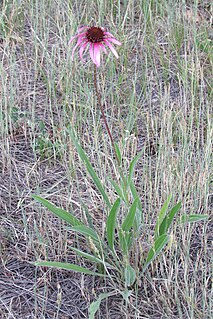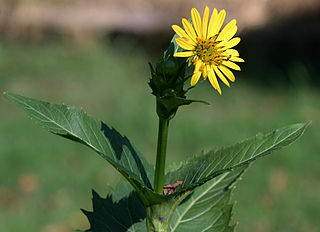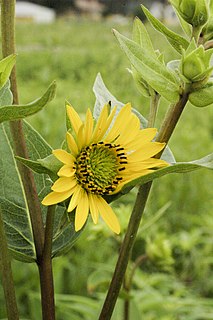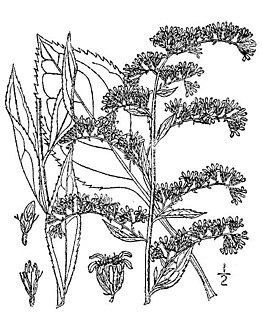
Silphium is a genus of North American plants in the tribe Heliantheae within the family Asteraceae.

Silphium laciniatum is a species of flowering plant in the family Asteraceae known commonly as compassplant or compass plant. It is native to North America, where it occurs in Ontario in Canada and the eastern and central United States as far west as New Mexico. Other common names include prairie compass plant, pilotweed, polarplant, gum weed, cut-leaf silphium, and turpentine plant. It is a rosinweed of genus Silphium.

Helianthus is a genus comprising about 70 species of annual and perennial flowering plants in the daisy family Asteraceae commonly known as sunflowers. Except for three South American species, the species of Helianthus are native to North America and Central America. The best-known species is the common sunflower, whose round flower heads in combination with the ligules look like the Sun. This and other species, notably Jerusalem artichoke, are cultivated in temperate regions and some tropical regions as food crops for humans, cattle, and poultry, and as ornamental plants. The species H. annuus typically grows during the summer and into early fall, with the peak growth season being mid-summer.

Echinacea angustifolia, the narrow-leaved purple coneflower or blacksamson echinacea, is a species of flowering plant in the family Asteraceae. It is native to North America, where it is widespread across much of the Great Plains of central Canada and the central United States, with additional populations in surrounding regions.

Platystemon is a monotypic genus of flowering plants in the poppy family containing the single species Platystemon californicus, which is known by the common name creamcups. It is native to Oregon, California, Arizona, Utah and Baja California, and is found in open grasslands and sandy soils below 6,000 feet (1,800 m) elevation.

Echinacea simulata, commonly called pale purple coneflower or wavy leaf purple coneflower, is a species of flowering plant in the family Asteraceae. It is native to the east-central states of the United States, including Arkansas, Georgia, Illinois, Kansas, Missouri and Tennessee. The U.S. Department of Agriculture also reports it as native to North Carolina and Virginia. Wavy leaf purple coneflower has a relatively small distribution, and its locations are still being determined. Its natural habitat is dry, calcareous, open areas such as barrens and woodlands.

Silphium perfoliatum, the cup plant or cup-plant, is a species of flowering plant in the family Asteraceae, native to eastern and central North America. It is an erect herbaceous perennial with triangular toothed leaves, and daisy-like yellow composite flower heads in summer.

Silphium integrifolium is a species of flowering plant in the family Asteraceae. Its common names include rosinweed, whole-leaf rosinweed, entire-leaf rosinweed, prairie rosinweed, and silflower. It is native to eastern North America, including Ontario in Canada and the eastern and central United States as far west as New Mexico.

Solidago rugosa, commonly called the wrinkleleaf goldenrod or rough-stemmed goldenrod, is a species of flowering plant in the family Asteraceae. It is native to North America, where it is widespread across eastern and central Canada and the eastern and central United States. It is usually found in wet to mesic habitats.
Atriplex acanthocarpa is a species of flowering plant in the amaranth family known by the common names armed saltbush, tubercled saltbush, and huaha. It is native to North America, where it is limited to the US states of Arizona, New Mexico, and Texas, and adjacent Mexico.

Parthenium integrifolium is a species of flowering plant in the family Asteraceae known by the common names wild quinine, American feverfew, and eastern feverfew. It is native to the eastern and midwestern United States.

Symphyotrichum georgianum is a rare species of flowering plant in the Asteraceae, the aster family. Its common name is Georgia aster. It is native to the southeastern United States where it is known from Alabama, Florida, Georgia, North Carolina, and South Carolina. As of 2013, it may be extirpated from the state of Florida.

Solidago arguta, commonly called Atlantic goldenrod, cut-leaf goldenrod, and sharp-leaved goldenrod, is a species of flowering plant native to eastern and central North America. It grows along the Gulf and Atlantic states of the United States from Texas to Maine, inland as far as Ontario, Illinois, and Kansas. It is primarily found in areas of woodland openings, such as outcrops or clearings.

Astranthium integrifolium, the entireleaf western daisy or eastern western-daisy, is a North American species of flowering plants in the family Asteraceae. It is native to the east-central part of the United States primarily the Cumberland Plateau and Ohio/Tennessee Valley. It is found in the States of Tennessee, Kentucky, Alabama, and Georgia, with isolated populations in Mississippi and West Virginia.

Solidago radula, the western rough goldenrod, is a North American plant species in the family Asteraceae. It is found primarily in the southern Great Plains and the Mississippi Valley of the United States, with isolated populations farther east in Kentucky, Georgia, and the Carolinas.

Silphium trifoliatum, commonly known as whorled rosinweed, is a species of flowering plant in the family Asteraceae. It is native to the eastern United States, where it is found east of the Mississippi River. Its natural habitat is open, grassy areas such as prairies, river cobble bars, and roadsides. It is a tall perennial that produces heads of yellow flowers in mid-summer through fall.

Silphium albiflorum, commonly known as white rosinweed, is a species of flowering plant in the family Asteraceae. It is native to the United States, where it is endemic to the state of Texas. Its natural habitat is in open, calcareous prairies.

Hypericum frondosum, the cedarglade St. Johnswort or golden St. John's wort, is a species of flowering plant in the St. John's wort family, Hypericaceae. It is native to the central and southeastern United States in dry, rocky habitats.
Silphium wasiotense, commonly called Appalachian rosinweed, is a species of flowering plant in the family Asteraceae. It is native eastern to North America, where it is endemic to the Cumberland Plateau of Kentucky and Tennessee. Its natural habitat is in dry open woodlands. It is considered rare throughout its range.
Silphium perplexum is a prairie species in the family Asteraceae, it is endemic to the state of Alabama. S. perplexum is commonly known as Old Cahaba rosinweed, a reference to the Cahaba River near which all populations of this species are found.


















